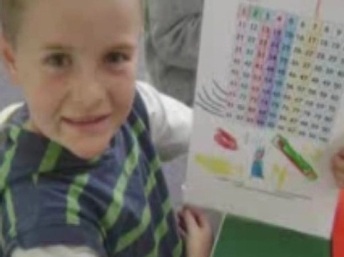|
Effective teachers shape mathematical language by modelling appropriate terms and communicating their meaning in ways that students understand. |
Language can be a barrier to understanding mathematics. Teaching the specific language of mathematics in an explicit way includes using terminology correctly, and explaining and modelling technical terms and concepts in ways which connect meaningfully with the children’s existing knowledge, language and experiences. To develop the language of mathematics with their students is complex and teachers must make it an integral but deliberate component of day to day teaching.
Making links between the specialized mathematical language of instruction and a different home language demands particular care. Variations of meaning and the nature of contexts must be considered carefully.
Furthermore, in many mathematical tasks and activities children encounter language and literacy barriers as they read and interpret written words and symbols. We must also ensure that the mathematics is accessible despite literacy challenges. In these stories we see that shaping mathematics language is a priority.
Exemplars:
|
Relating mathematical language to something they were working on also helped them to remember and to gain an understanding of what they had learnt; for example, relating odd numbers to ‘the odd one out’. It was useful to get the children to make two lines to see if they were part of a pair or whether there was an odd one out, then to show this pictorially to see the patterns of odd and even numbers.
(St Mary's School)
|
|
I have often found that children struggling with mathematics do not understand the language demands of the task and therefore are unable to access the maths in order to succeed in the subject. With this knowledge in mind I ensured that children were given exposure to appropriate language which I modelled consistently. It is important that teachers understand that the language necessary for learning and educational attainment, takes between five to seven years to develop thus needs to be explicitly taught through the use of scaffolding and clear instructions (Cummins, 1978, 2000b cited in Baker 2001). I ensured that I consciously planned for and taught language objectives and mathematical objectives concurrently, to allow the students an “opportunity to learn what is most relevant at the time for them to participate in class, so that they could be fully engaged in learning activities and challenged at an appropriate conceptual level” (Gibbons, 2002, p.13).
(Sylvia Park School)
|
|
Teaching the language of maths: It was evident from the start that these children did not have a lot of ‘maths language’. When asked how did you work that out they would say, “My brain just thought it,” or ‘I just know that,” or a simple shrug of the shoulders. They were not able to clearly articulate exactly what they had done to work out the answer. I had to make sure that every day and in every possible way I was feeding in the language of maths, by modelling, questioning of the children, and providing explanations and examples of what different maths words meant. I noticed that once they understood the language more, they were then able to begin to use it when explaining how they had worked out or come to an answer.
(Awapuni School)
|
|
Another focus was developing mathematical language. Initially, when I worked with the students, they were unfamiliar with mathematical terms which made it difficult for them to explain their thinking as they lacked specific terminology. As students became more familiar with maths vocab their explanations of their thinking became much more succinct.
I found the two factors that appeared to most aid the students' learning was their increased familiarity with materials and vocab, as they could then both demonstrate and explain their thinking. This gave the students great confidence in what they were doing and they became increasingly able to identify where things may have gone wrong and were then able to self-correct.
(Rangikura School)
|
